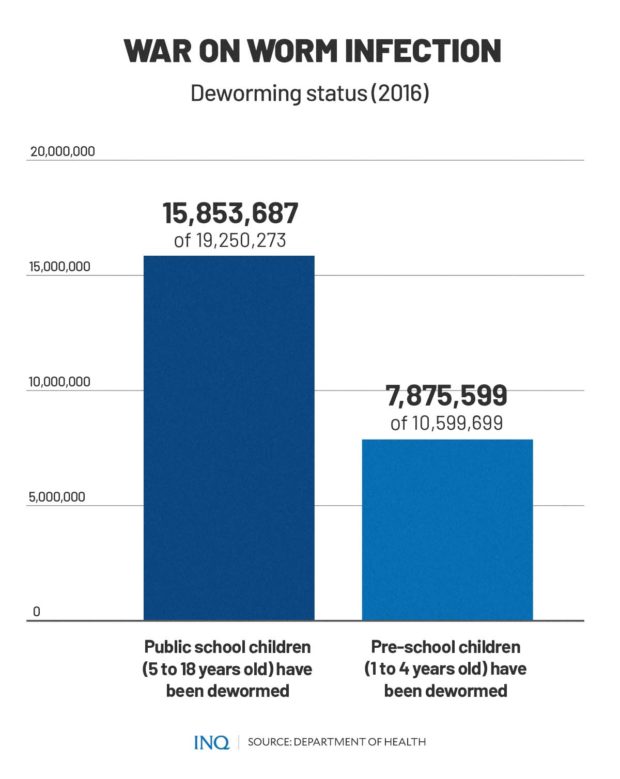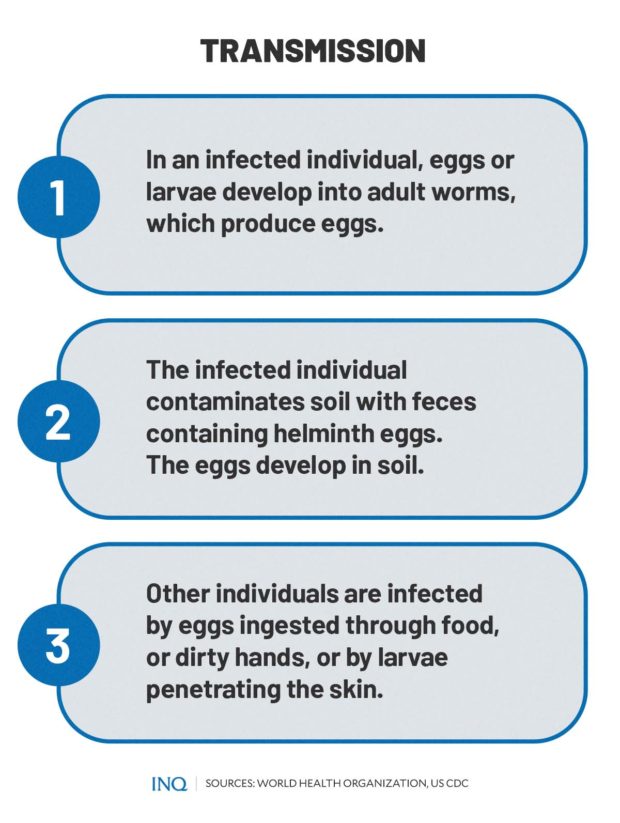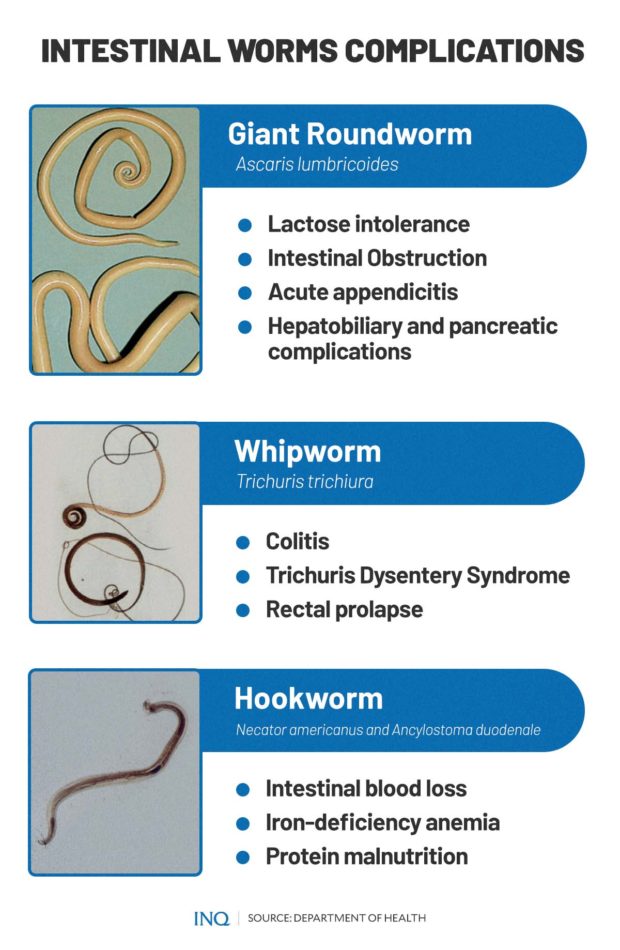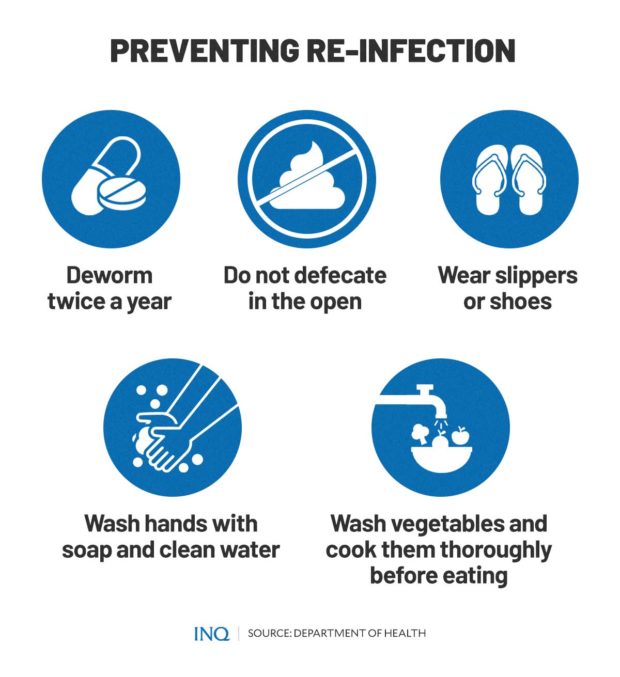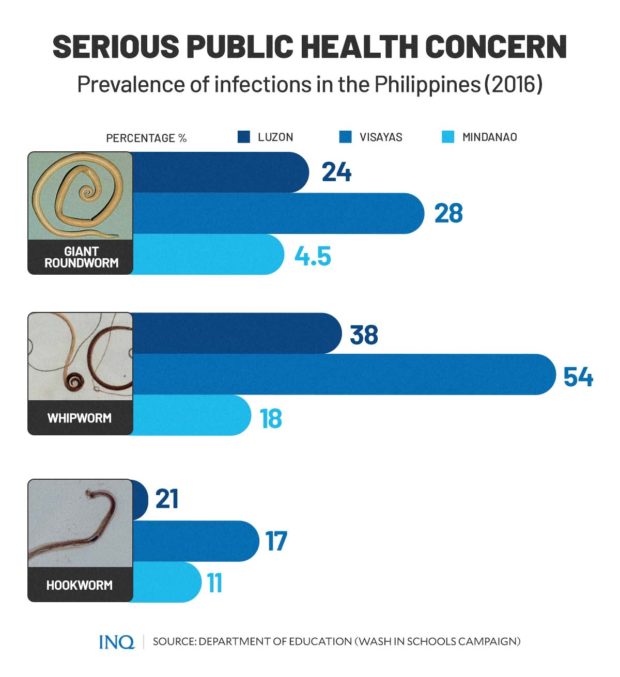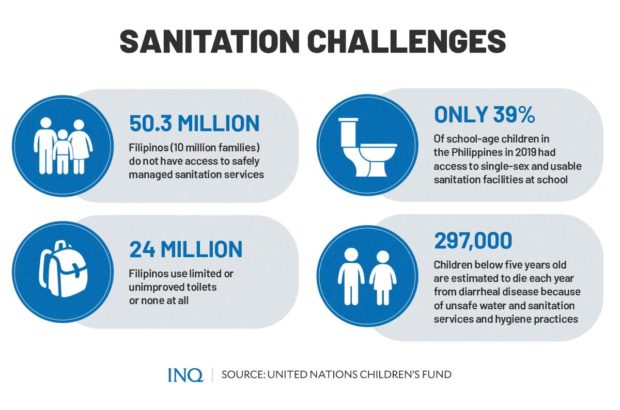National Deworming Month: Infections mirror deep poverty

Teachers and health workers give children in Santa Rosa, Laguna deworming medicines. PHOTO FROM FACEBOOK PAGE OF APLAYA ELEMENTARY SCHOOL
MANILA, Philippines—Back in 2014, the program i-Witness shed light on the serious problem confronted by children in Mercedes, Camarines Norte—severe malnutrition, which is even exacerbated by parasitism.
Kara David, one of the program’s hosts, encountered 69-month-old Angela, who only weighed 10.6 kilos then, definitely lower than 14.9 kilos, which is the prescribed weight for her age.
The documentary narrated how the girl and her two siblings shared a small piece of crab for dinner—a clear indication of hunger but this was not the only problem because the children in Pugad Lawin were likewise infected with intestinal worms.
RELATED STORY: Big number of kids with worms in Bicol alarming, says DOH
Intestinal worms, like giant roundworms, whipworms, and hookworms, are parasites that come in different sizes and live inside the intestines, causing diseases and complications.
Article continues after this advertisementThe Department of Education (DepEd), which has the goal of deworming 85 percent of students twice a year, said that as of 2016, the prevalence of roundworm infections in the Philippines is still above 20 percent:
Article continues after this advertisement• Luzon
• Giant Roundworm: 24 percent
• Whipworm: 28 percent
• Hookworm: 4.5 percent
• Visayas
• Giant Roundworm: 38 percent
• Whipworm: 54 percent
• Hookworm: 18 percent
• Mindanao
• Giant Roundworm: 21 percent
• Whipworm: 17 percent
• Hookworm: 11 percent
In the “Risk Factors for Human Helminthiases in Rural Philippines,” which was written by Ross et. al. in 2017, it was said that the problem is a serious public health concern, with 16 of 17 regions “endemic with more than 50 percent overall prevalence.”
This was the reason that the Philippines, every January and July, marks the National Deworming Month (NDM) to strengthen the campaign to eliminate intestinal parasitism, especially in children.
“It aims to treat and to prevent Soil-Transmitted Helminth (STH) infections that have a detrimental impact on children’s growth and development. As of 2016, the prevalence of roundworm infections in the Philippines still falls above 20 percent,” the DOH said.
The 2017 World Health Organization (WHO) Guidelines recommend mass deworming for school-age children living in places where the prevalence of intestinal worms is 20 percent or higher.
Held twice a year, the NDM is done by “synchronizing the schedules of Mass Drug Administration for Soil-Transmitted Helminths in the schools and the community,” the DOH said.
It said that in 2016, 15,853,687 of 19,250,273 public school children (5 to 18 years old) have been dewormed while 7,875,599 of 10,599,699 pre-school children (1 to 4 years old) have been dewormed.
The coverage set by the WHO is 75 percent, but the DOH set the coverage goal to 85 percent of children “dewormed” in the presence of a health personnel and with parent’s consent.
Intestinal worms
According to the Research Institute for Tropical Medicine, intestinal worms mostly hit poor and deprived communities. The infections have negative effects on the health of the “host,” worsening bodily functions that could lead to complications, and sometimes, death.
STH infections are caused mostly by giant roundworms (Ascaris lumbricoides), whipworms (Trichuris trichiura), and hookworms (Necator americanus and Ancylostoma duodenale).
The DOH said high risk groups include children, female teens, pregnant women, farmers, soldiers and indigenous peoples. Here are the possible complications that could result from an STH infection:
• Giant Roundworm
• Lactose intolerance
• Intestinal Obstruction
• Acute appendicitis
• Hepatobiliary and pancreatic complications
• Whipworm
• Colitis
• Trichuris Dysentery Syndrome
• Rectal prolapse
• Hookworm
• Intestinal blood loss
• Iron-deficiency anemia
• Protein malnutrition
Back in 2006, Bethony et. al. said that all over the world, an estimated two billion people are infected with STH—giant roundworms (807 million), whipworms (604 million), and hookworms (576 million).
The DOH stressed that open defecation outside latrines by infected persons significantly contributes to the transmission of diseases through the contamination of soil and water supply.
This, as the eggs or larvae develop into “adult worms” in an infected person. The worms then produce eggs. The infected individual contaminates the soil, and even the water, with feces containing worm eggs, which develop in soil.
It was explained by the WHO and the United States Centers for Disease Control and Prevention that the rest of individuals get infected by eggs ingested through food, or dirty hands, or by larvae penetrating the skin.
Detrimental
Sangalang et. al.’s MedRxiv article stressed that diarrhea, STH infections, and malnutrition threaten the lives of millions of children all over the world, especially in places where inadequate water, sanitation, and hygiene (WaSH) drive disease risk.
RELATED STORY: Gov’t seeks private sector help in fight to end kids’ malnutrition
This, as the DOH said that STH infections can cause anemia, malnutrition, weakness, impaired physical and cognitive development resulting in poor growth and school performance of children.
RELATED STORY: Duterte’s last loan, $178M from WB, eyes 2022 targets vs stunting
It was stressed by the United Nations Childrens’ Fund (Unicef) that sanitation is significant to the overall health and wellbeing of communities, saying that yearly, an estimated 297,000 children die because of diarrheal diseases.
Unicef’s 16-nation study revealed that children below five years old are on average 20 times more likely to die from illnesses linked to water that are not safe for consumption and bad sanitation, than from conflict.
Every year, 85,700 children below five die from diarrhea, compared with 30,900 from conflict. Some 72,000 children below five die yearly from illnesses linked to WaSH-access problems, compared to 3,400 from war-related violence.
The DepEd said one in every two schoolchildren is infected with worms, affecting every social class: “Worms are so widespread that some even believe that it is normal or even beneficial for children to have worms.”
However, the reality is worms survive by stealing nutrients from the person they infect. People with worms suffer from lack of nutrients, weakness and feeling tired, like Angela, who was being carried by her mother to and from school.
“As worms travel inside the body, they sometimes end up in the lungs, causing cough. In rare, severe cases, obstruction of the intestines or bile ducts may lead to death,” the DepEd said.
Preventing STH infections
The DOH’s deworming initiative is held twice a year This, as children are easily prone to getting infected again, therefore, deworming is needed every six months because it will prevent chronic infection and a heavy worm load.
According to the DepEd, deworming tablets get rid of worms in a person’s body. The medicine is called albendazole or mebendazole. Both act by stopping the worm from moving, leading to its death. Because the worms can no longer move.
“It is very effective and only a single dose is needed, regardless of the child’s weight,” it said, stressing that “it is not true that the medicine will cause the worms to go out of the child’s mouth and nose.”
RELATED STORY: Remedy worsened kids’ stomach ache after deworming—DOH
However, as long as people continue to defecate in the open, children can easily get infected with STH again. This was the reason why DepEd said that proper handwashing is really important.
Here are some steps listed by the DOH to prevent children from having worms again:
• Deworm twice a year because deworming medications only kill the adult worms. Deworming twice a year helps kill the remaining worm eggs and prevents the spread and reinfection of other individuals.
• Do not defecate in the open as it spreads worm eggs into the soil, water or environment which may come in direct contact with the skin, water system or food.
• Wear slippers or shoes to prevent hookworm infections which usually come from direct skin contact with contaminated soil.
• Wash hands with soap and clean water since worm eggs can be found in contaminated feces, soil or water, it is important to wash your hands before eating to prevent infection.
• Wash vegetables and cook them thoroughly before eating because worm eggs can survive in the soil for months and can contaminate vegetables and fruits. Cleaning raw fruits and vegetables with clean water and thorough cooking (boiling point) will help kill the worm eggs and prevent infection.
Finally safe?
Sanchez et. al., as cited by Jessica De Guia and Mary Jane Flores, researchers from the De La Salle University, said intestinal worms usually thrive in impoverished regions where lack of clean water, improper sanitation and hygiene exist.
Unicef said the world is “alarmingly off-track to deliver sanitation for all by 2030” and the Philippines is on the same trajectory, saying that 50.3 million Filipinos—10 million families—do not have access to safely managed sanitation services.
Out of these, 24 million use limited or unimproved toilets or none at all: “ Safely managed sanitation means the use of improved toilet facilities which are not shared with other households and where the excreta are safely disposed on-site, or are transported and treated off-site.”
In the i-Witness episode, the barangay nutritionist said most residents defecate in the river while most children excrete feces just outside their homes, where most of them play barefoot.
The 2019 Annual Poverty Indicators Survey showed that four out of five families are already using improved sanitation facilities that are not shared with other households. However, 1.8 million families are still using unimproved toilets or none at all.
RELATED STORY: Unicef on kids after Odette: ‘We can’t leave them behind’
The top three regions with the highest percentage of families with no toilet facility or still practicing open defecation were the Bangsamoro Autonomous Region in Muslim Mindanao (16.1 percent), Bicol Region (11.5 percent), and Eastern Visayas (8.9 percent).
Based on the WHO and Unicef 2019 report on WaSH in schools, only 39 percent of school-aged children in the Philippines at the time of survey had access to single-sex and usable sanitation facilities at school.
RELATED STORY: Palace: A lot more must be done to lift Filipino families out of poverty
TSB
